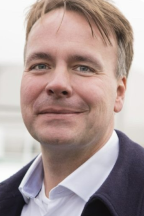Developers Eye Huge Untapped Potential of Offshore Wind

By Simon West
_2.png)
Excitement continues to mount among breakbulk movers in the Middle East as governments throughout the region press ahead with ambitious plans to pivot their economies towards more sustainable forms of energy production.
While the Gulf Cooperation Council remains heavily dependent on oil and gas – by the end of last year, fossil fuels accounted for 72 percent of the US$631 billion estimated capital expenditure on regional energy projects, according to the London-based Energy Industries Council – announcements of big infrastructure projects for cleaner energies such as onshore wind, solar, hydrogen and nuclear – all of which require significant breakbulk support – are starting to come thick and fast.
One industry in the region, though, remains untapped: offshore wind.
According to the EIC, just two projects in the GCC are in the pipeline: a 500-megawatt, or MW, floating off-shore windfarm in Saudi Arabia being developed by Abu Dhabi-based Plambeck Emirates, and an offshore facility in Bahrain. Both are slated to come online in 2027.

Speaking to Breakbulk, Mohammad Jaber, COO at DSV Abu Dhabi and MD for Air and Sea, pointed to several possible reasons for the slow-paced build-out compared with other parts of the world.
“When we look at renewable energy in the region, solar power systems offer a higher return on investment, especially with our long days and heat levels,” he said.
“Maintenance and operating costs also support more investment in solar projects for the same amount of energy production. A large part of the region too has very high potential for oil and gas exploration in those same sea areas.”
Jaber, who sits on the Breakbulk Middle East Advisory Board, a group of industry professionals brought together to help shape the program for this year’s event, said another key factor was safety and security.
“You can see a lot of those areas are very active for marine traffic, like the Red Sea and the Arabian Gulf, while [there are] some geopolitical challenges that would increase the investment risks in those areas,” he said.
Gradual Wind Power Buildout
Mohammed Atif, Middle East area manager for DNV, an Oslo-based technical adviser to the energy and maritime industries, said despite the GCC housing some of the world’s largest clean energy projects, the expansion of onshore capacity in absolute and percentage terms compared with other regions has been more gradual.
“In those places [in the GCC] where renewables have gained traction in terms of solar and wind, it has obviously been onshore. And that is to do with both cost and complexity,” Atif said.
“Unlike in Europe where you have stringent permitting and environmental issues – a lot of ‘not in my backyard’ concerns – the governments here have more land, and have a more streamlined process to allocate that land for onshore projects. So, you do not necessarily want to go offshore if you have plenty of access to onshore sites.”
The Dubai-based consultant also pointed to geographical constraints. “You have some very good offshore resources around Oman and near the Atlantic area around Morocco. But generally speaking, there are not that many very high impact offshore areas; there are some, but nowhere near as many as perhaps you have got off the coasts of North and South America, the UK, the North Sea and Europe, for example.”
A non-starter, then? Actually, not quite. The good news for breakbulk and project cargo is that the tide may be turning, with leading developers starting to dip their toes into this nascent market.
In addition to the two projects already in development, clean energy operator Masdar, for example, last year announced it was partnering with National Petroleum Construction Company, or NPCC, to explore renewable energy opportunities in the UAE.
According to an MoU signed in May, the two Abu Dhabi-based firms will initially focus on offshore wind before directing their attention to other sectors including green hydro-gen and battery storage technologies.
Masdar, whose Abu Dhabi office was unable to provide Breakbulk with additional information on their plans in the UAE, is one of the world’s largest clean energy developers with operations in more than 40 countries.
The company, a venture between Abu Dhabi National Oil Company, or ADNOC, Abu Dhabi National Energy Company and Mubadala Investment Company, is targeting a renewable energy portfolio capacity of at least 100 gigawatts, or GW, by 2030, and an annual green hydrogen production capacity of up to 1 million tonnes by the end of the same period.
Masdar may be a first mover in the UAE, but, according to experts, others are set to follow as technology improves and costs come down.
Tempered Offshore Promise
In its Energy Transition Outlook 2022, DNV expects the Middle East and Africa, or MEA region, to boast some 18 GW of installed fixed offshore wind capacity by the end of the decade. By 2050, fixed offshore capacity will have expanded to 78 GW, along with a further 14 GW of floating capacity.
On a global scale, such figures are relatively modest – in the same report, DNV said China and Europe could house 609 GW and 367 GW of offshore wind capacity, respectively, by 2050 – but would still hand project logistics a steady stream of cargo-carrying contracts for decades to come.
The Global Wind Energy Council’s outlook for the Gulf is even more bullish.
The organization estimates that Oman alone boasts 61 GW of fixed and 118 GW of floating offshore wind potential within 200 kilometres of its shoreline, with the most prospective areas located off its gusty, southern Arabian Sea coast.
According to Atif, the game-changer for Oman could be green hydrogen.
Blessed with one of the highest levels of solar irradiance in the world, the sultanate has set its sights on becoming a world-leader in renewable hydrogen and ammonia production, with several large-scale projects already in development.
The country is targeting output of 1.25 million tonnes of green hydrogen by 2030.
To fast-track its hydrogen ambitions, Oman late last year established a green hydrogen procurement company, Hydrom. DNV has been brought on board to provide technical advice to the new entity.
Such plans would require the deployment of thousands of wind turbines and solar panels to produce energy to power water desalination and electrolysis plants that in turn would make zero-carbon hydrogen.
“If the industry moves ahead as planned, you are going to swallow up those landsites where you have your onshore wind and solar resources significantly faster than you would have done otherwise,” Atif said. “By 2030 to 2035 you would probably start to look at offshore resources.”
Look Beyond 2030
Ryan McPherson, director of Middle East, Africa, Russia and CIS for the EIC’s Middle East branch, agreed that large-scale buildout would likely take off post-2030.
“There is no doubt we are seeing positive movements for the sector to kick off. But this will depend on how consistent the region is with future project announcements, and subsequently if other strong financial support and regulatory legislations are made specifically for offshore wind development to back this,” he said.
 “The GCC has a number of advantages that make it a great location for offshore wind projects to which our members (mostly medium and small size energy supply chain companies) from around the world can contribute to in different capacities. The region is home to major oil and gas companies, infrastructure and expertise, which are easy to diversify to offshore wind. EIC members working in the North Sea have plenty of experience in this regard and are able to contribute to diversifying the activities of companies working in the GCC to offshore wind.
“The GCC has a number of advantages that make it a great location for offshore wind projects to which our members (mostly medium and small size energy supply chain companies) from around the world can contribute to in different capacities. The region is home to major oil and gas companies, infrastructure and expertise, which are easy to diversify to offshore wind. EIC members working in the North Sea have plenty of experience in this regard and are able to contribute to diversifying the activities of companies working in the GCC to offshore wind.
“GCC countries can also produce wind turbines locally as they have metals and plastics required to produce turbines daily. On top of that, the GCC is home to companies such as Masdar that holds stakes in projects in other regions such as the Dudgeon offshore wind farm in Norfolk and Hywind floating wind farm in Scotland. There is also that drive for green hydrogen.”
As offshore wind development needs time to ramp up, in the meantime the GCC’s focus on onshore renewable projects is translating into serious opportunities for the logistics supply chain.
In the UAE, further expansion work is being planned at the Mohammed bin Rashid Al Maktoum Solar Park close to Dubai, billed as the world’s largest single-site solar PV facility to operate under an independent power producer, or IPP model.
The project, which is being implemented by the Dubai Electricity and Water Authority, or DEWA, is aiming to generate 5 GW by 2030, with investments worth about US$13.6 billion. It currently has a capacity of 1.6 GW.
McPherson pointed to Dubai’s Clean Energy Strategy 2050, which has set a target of producing 100 percent of Dubai’s power from green energy sources by 2050. “As a result, we believe the UAE will massively ramp up its renewable energy capacity to achieve this goal.”
Elsewhere, Kuwait’s over-reliance on crude has triggered efforts to diversify its industrial base, with the government aiming to source 15 percent of electricity generation from renewables by the end of the decade.
Plans are already in place to rapidly expand capacity through a series of commercial-scale onshore wind, solar and hydrogen facilities. Some projects are starting to take shape, such as the four-phase Shagaya renewable energy plant, which is calling for a planned 4 GW of capacity by 2030.
‘Exciting’ Plans in the Region
Peter Rondhuis, CEO of trans-port specialist Roll Group, said developments in the GCC were “very exciting.”
The Netherlands-headquartered company recently announced it had formed an alliance with ADNOC Logistics and Shipping to jointly implement heavy haulage solutions for both onshore and offshore projects in the GCC.
As part of the deal, Roll Group set up a permanent base at ADNOC’s Mussafah Offshore Supply Base close to Abu Dhabi, the largest integrated logistics base in the Gulf.
“Roll Group is just now completing the delivery of the UAE’s first wind energy project and we are seeing many other wind energy projects of much greater size being developed across the region in the UAE, Saudi Arabia and Oman,” he said.
 “Many of these projects are of course being developed together with solar PV projects to power hydrogen plants and this is in fact the sector that we think has major potential for the region. If you look back a couple of years, there was almost no mention of hydrogen projects and right now there are already 18 projects in the pipeline just for the UAE.”
“Many of these projects are of course being developed together with solar PV projects to power hydrogen plants and this is in fact the sector that we think has major potential for the region. If you look back a couple of years, there was almost no mention of hydrogen projects and right now there are already 18 projects in the pipeline just for the UAE.”
Rondhuis was also optimistic for the region’s offshore wind prospects.
“We are seeing major developments in all areas of the world. Despite the low pipeline, we are convinced that the Gulf will also have more projects in the years to come. And we know from experience that the GCC is very effective, with short periods between planning and execution.”
Colombia-based Simon West is senior reporter for Breakbulk.
TOP PHOTO: London Array offshore wind project, UK. CREDIT: London Array Limited
